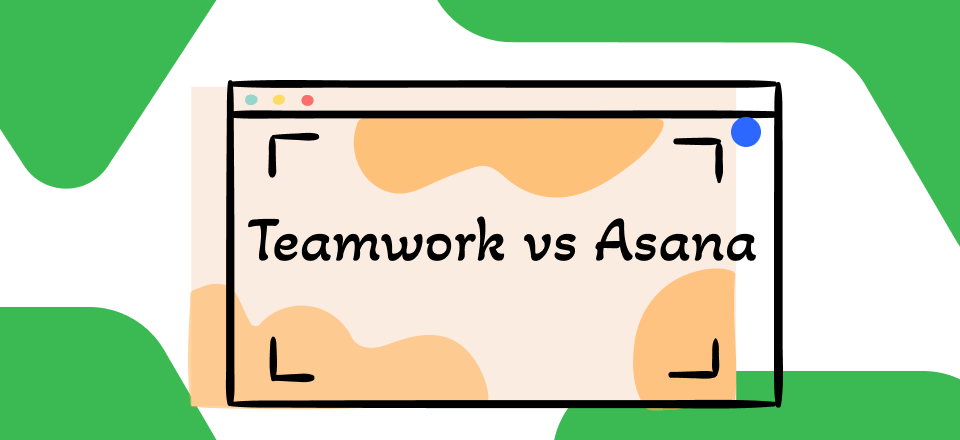Wrike vs Monday – Choose the Right Project Management Tool

Wrike vs Monday
The trend toward remote work is clearly on the rise. A survey showed people spend at least half their time working remotely. More than half of the employees at Fortune 1000 businesses are classified as “mobile,” meaning they spend at least part of their work weeks away from the office. So, the obvious follow-up issue is handling such many remote workers.
While the phone and email are tried and true methods, they may be cumbersome and demand a set protocol, which can be counterproductive when working remotely. That’s where software as a service (SaaS) projects and task management apps like Monday.com and Wrike come in. With the help of modern project management software, team members from all over the globe may work together on the same set of tasks, independent of their physical location.
A project planning software that all your teammates can quickly use can greatly enhance the transparency of your projects and workflows, whether you’re working remotely or in an office, which will improve your team’s ability to work together and communicate, leading to greater output in less time.
Table of Contents: hide
What is Wrike?
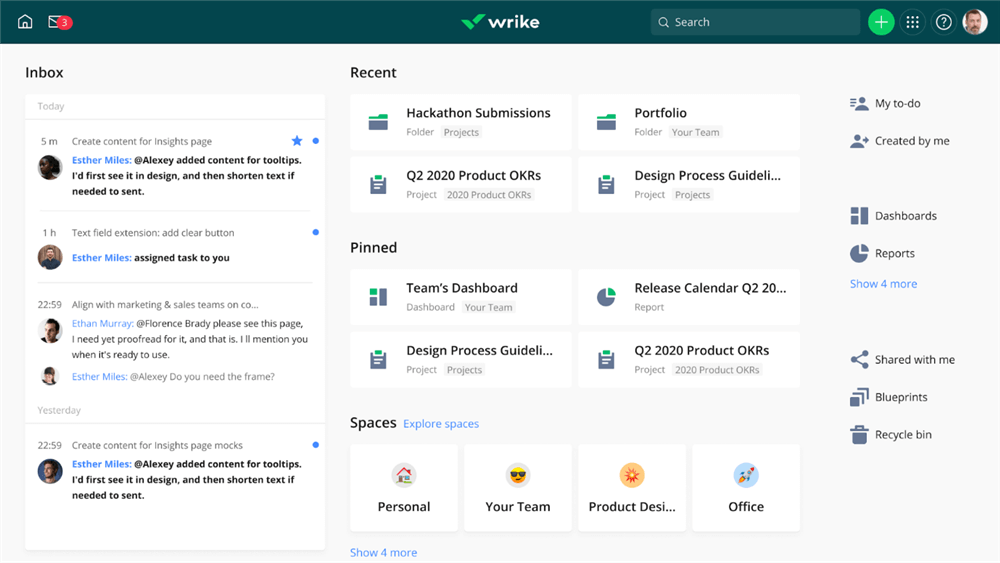
Wrike Interface
To facilitate communication and cooperation between in-house staff and external contributors, businesses of all sizes may benefit from Wrike, a cloud-based project management platform that offers visibility and efficiency. Wrike’s free plan resembles a spreadsheet, but the paid plans include various charts and graphs to help you analyze your work.
Wrike was established in 2006, and its project management software was introduced the following year. In the first decade of the company’s existence, user numbers increased steadily. Wrike now works with over 20,000 businesses in 140 different countries. Wrike is a platform with a wide variety of functionality for various teams and budgets. It is most often used for IT project management, but it also has tools for advertising, design, and customer support.
Key Features of Wrike
Let’s review the amazing features that Wrike has to offer to its audience:
Team Collaboration Tools
Wrike makes it simple to work with your team like other project management software. Any team member may see a real-time feed of recent activity across the whole organization or for a specific project. Inviting customers, contractors, suppliers, or any other third – party to see the progress of their initiatives and collaborate with you towards completion is simple and costs nothing extra.
In addition, your team may have chats about individual tasks or the whole project, making it easier to keep track of connected materials. Together, these capabilities, plus a wealth of real-time reporting and analytics, simplify internal and external collaboration.
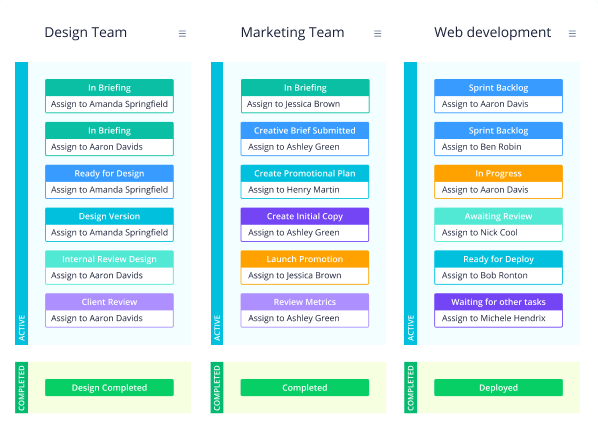
Wrike Team Collaboration Tools
User Design
The topic of the user interface is covered extensively in every software review. Even if people have different tastes, the consensus is that Monday.com’s interface is very easy to use since it is very clean and bright and has features that allow users to drag and drop items. This makes it a very simple system to get up and running with.
Automated Workflows
Wrike does a great job explaining and streamlining the automation process without compromising support for complicated workflows. Wrike’s workflow designer allows you to effortlessly create automated systems spanning numerous business applications since it interfaces with over 400 third-party products.
Up to 100 automated tools per profile may streamline everything from approval procedures and intelligent traffic management to statistics, strategic planning, and job assignments. The process builder enables users to create automation with as little as two “if, then” statements and as many as ten automated activities. On the other hand, the workflow builder is restricted to paid plans.
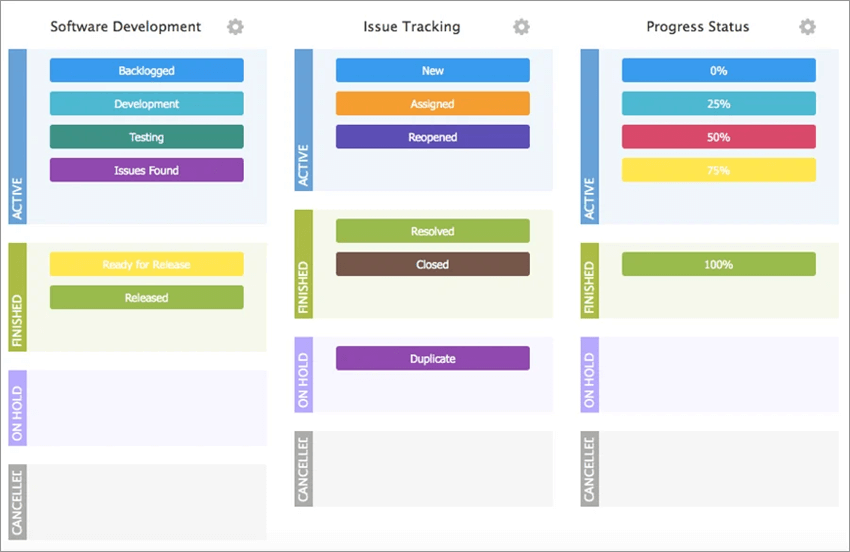
Wrike Automated Workflows Interface
Custom Request Forms
Wrike’s custom form builder simplifies the process of making forms for anybody who uses them or plans to in the long term. While Wrike recommends them for usage with requests, you may put them to almost every other use you can think of.
Depending on the user’s selection, you can customize the confirmation page they’re sent to after completing. Also, the system can assign tasks, fill sub-tasks, and automatically calculate due dates depending on when the form was submitted.
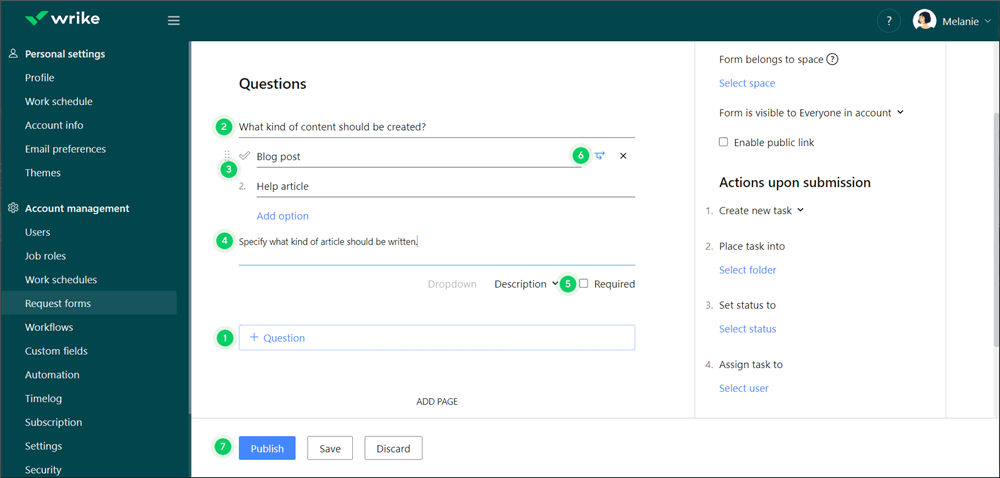
Wrike Custom Request Forms
Department-Specific Solutions
Having many divisions use the same project management software may help you save money and get everyone on the same page. Wrike is one of the most flexible tools available today, whereas others excel only in certain situations or are better suited to certain departments.
Advertisers, creative teams, expert services companies, business functions, IT workgroups, product owners, and more may all find a tailored solution to meet their needs. Wrike may serve as a company-wide or department-level project management tool, depending on your needs.
Real-Time Analytics
Charts, certain reports, visualizations, and statistical widgets in Wrike are automatically updated within 15 minutes, so you never have been concerned about looking at (or presenting) stale data.
This is a major perk if you’re trying to track several different tasks simultaneously. We like that Wrike provides us with up-to-date metrics in real-time since this feature is not standard in other project management software.
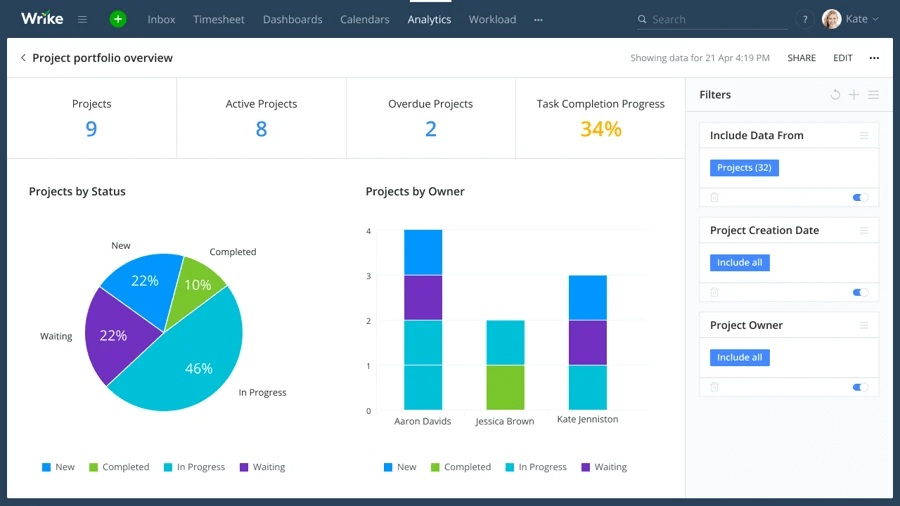
Wrike Real-time Analytics
Enterprise Grade Functionality
Wrike gives you access to the same project management features used by large corporations. File sharing, asset publication, project and user-level time tracking, and more are all possible within the platform, and business-grade safety measures keep everything safe
In addition, the sophisticated features allow your organization to be ready for future expansion while giving everybody time to get used to them. You can even stumble across process bottlenecks and enhancement opportunities. Hundreds of free templates are available to get you started, giving you many options for customizing the program to your specific needs and boosting your productivity in novel ways.
Pre-purposed Spaces and Templates
Teams in resources planning, technical service, and product design, and groups in advertising, creative, and information technology have dedicated areas for their work. Each workspace has pre-built templates that make it easier to launch a project, delegate responsibilities, and track progress, so choosing the appropriate one is vital.
There are blank forms, or “templates,” within each one. Add what Wrike terms use-case templates with the help of the space’s wizard (the bright green “+” symbol). Initiatives, tasks, graphs, statistics, and request forms are all included in the package of pre-made examples. To organize a complicated project using a Kanban Board, you may consist of the Simple Agile area and a Kanban Template.
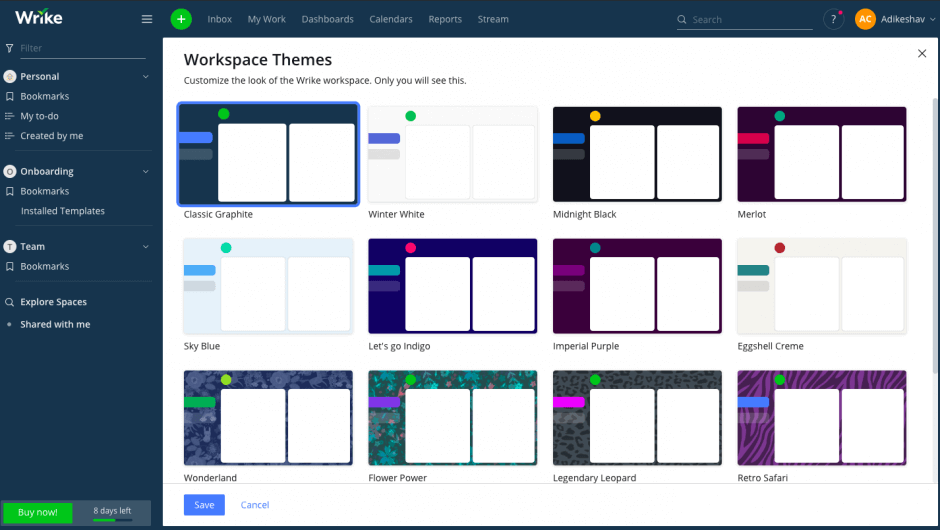
Wrike Templates
Wrike Assistant
The Wrike Assistant is a built-in feature accessible from the menu bar. By selecting the question mark, you’ll be sent to a page where you can read up on Resources Planning, the Basics, the Wrike Guide, Applications & Integrations, and What’s New.
The assistant is also a great resource for learning about new features and upgrades, as well as how to integrate third-party apps. In addition, if you’re on the Business Plan or above, you may apply form to have a Wrike representative set up a demo.
Wrike Integrations
Compared to the other project management tools we’ve looked at, Wrike is the only one allowing staggered integrations across its plans. To provide two examples, the Professional program and above is required to pair the Microsoft Office suite, and the Business plan is required for a Salesforce connection.
You may create connections using services like Zapier and IFTTT (or program your own). The free plan already includes rudimentary interfaces with popular cloud-based storage providers and desktop applications like Google Drive and Office 365. At least now you know how to get around that meagre storage limit.
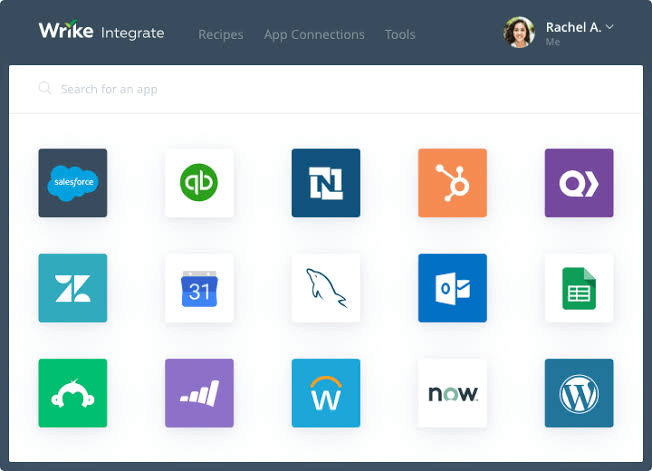
Wrike Integrations Overview
Wrike Add-Ons
Add-ons, which are specialized feature bundles, are also available for Wrike. These may be added singly, or you can choose a bundle. Wrike’s two most prominently promoted plans are the Professional Services Plan and the Marketers Plan. We can’t vouch for every single one of these extras, but we had a blast experimenting with the marketers’ bundle.
One useful feature for design groups was its seamless interaction with Adobe’s Creative Cloud. Wrike Proof is an intriguing app since it lets you add notes to photos and videos. After some trial and error, we decided that Google’s suite of collaborative tools better suited our needs.
What is Monday.com?
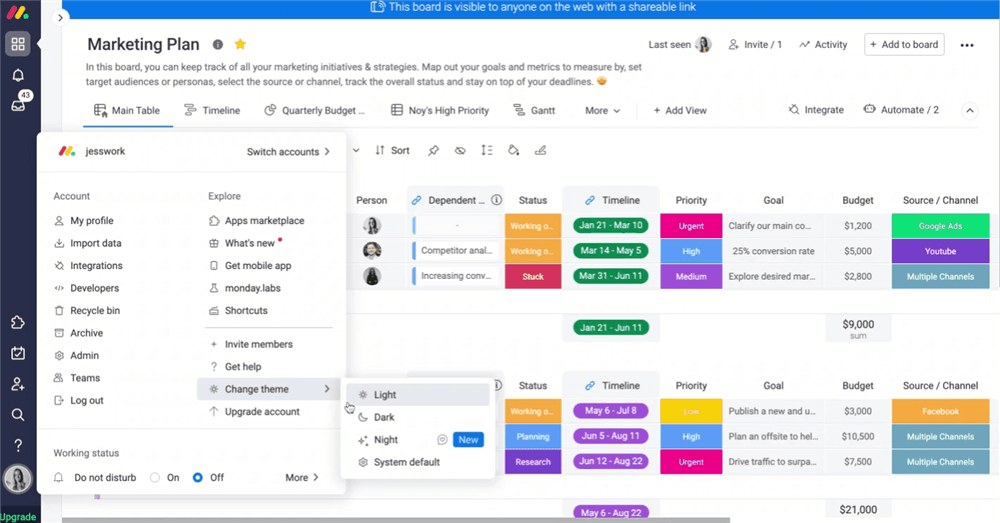
Monday.com Interface
Monday.com is an easy-to-use and adaptable work operating system intended to reduce the amount of work you have to do. In addition to the administration of projects, this all-in-one platform for work management may also be used for a broad variety of other purposes.
Therefore, you can utilize Monday.com as a combination of project management software, a communication tool, a task management app, a recruiting tracker, and a sales customer relationship management system. When Monday.com can take care of every business requirement inside the same platform, there is no need to spend time and energy switching between multiple tools and applications.
Isn’t it cool? Our user interface is an absolute pleasure to work with, making it possible to get new teams up and running in almost no time. Even with the most affordable pricing plan, you will have complete access to our hundreds of practical and adaptable templates.
You can also follow the guide to find Monday.com alternatives.
Key Features of Monday.com
Views and Boards Feature
Boards serve as the primary interface for all users on monday.com. Users may modify and adapt boards to facilitate the management of everything from individual projects to whole departments, as well as processes and communication. Using pre-made process templates, they can have it up and running in no time. Users may organize and visualize tasks in various ways, from calendars to Gantt charts to timelines, all accessible from inside boards.
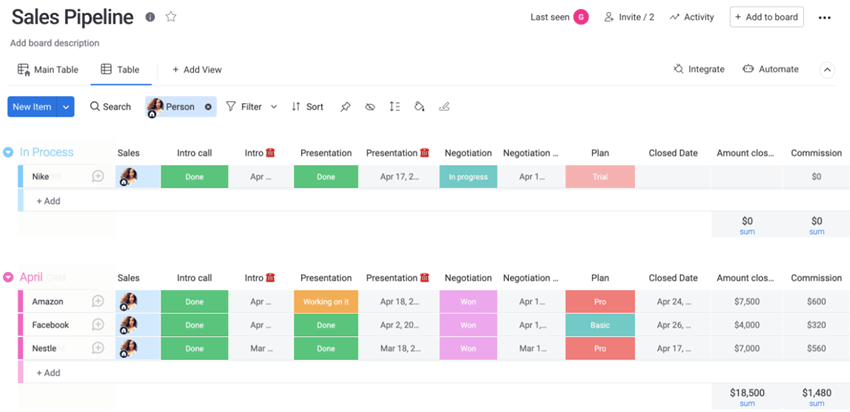
Monday Views And Board
Monday Integrations
Monday.com helps remote teams to manage work time with built-in automation. It interfaces with many major programs, including Dropbox, Google Drive, Team, etc. This allows teams to get more work done with less movement between tools. Moreover, repetitive chores may be minimized with the help of customizable automation through no-code rules, such as the automated sending of emails upon the arrival of a due date or the sending of updates upon the completion of a job.
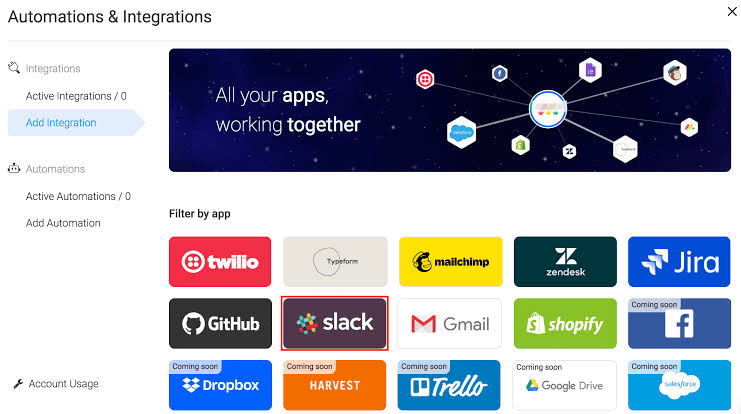
Monday Integrations Overview
Task management
The task management tool on Monday.com allows you to delegate work to team members, establish deadlines, give priorities, and monitor your team’s progress. You can track what has to be done each day and each week, and you’ll get a reminder two days before a deadline. When a user’s job is finished, they will get a notification email. The tasks may be prioritized, and their statuses updated accordingly to show you which are more pressing. Everyone on the team can see who has what to do, thanks to Monday.com.
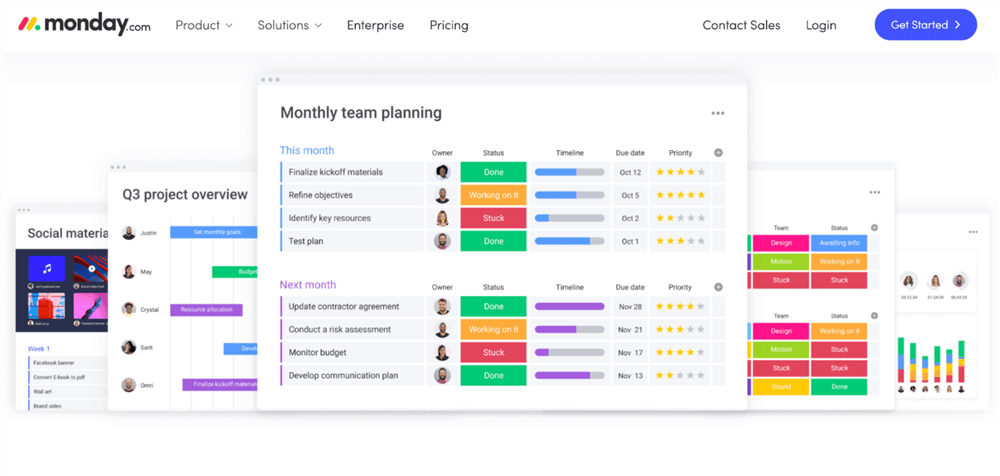
Monday Task Management
Monday Collaboration
Monday.com’s collaboration function enables members of a team to communicate with one another and collaborate on assignments by @mentioning one another. The use of Monday work docs is one characteristic that sets Monday Work Management apart. Teams can create live-action items, co-edit papers in real time using work docs, and embed boards within their editing documents.
Workflow Management
Monday Work Management is an end-to-end suite for streamlining operations across teams, with four specialized modules built on top of the core product. There are also Monday Sales CRM, Monday Marketer, and Monday Developer, in addition to Monday Projects. Each product includes Monday work management and contains the project boards, automation and management capabilities that teams demand. These solutions, however, are designed to meet the requirements of a certain workflow, making it simple to begin using the platform.
Monday.com Reporting Analytics
Something like monday.com should be sufficient if you’re attempting to plan and manage effectively without too many bells and whistles if you’re operating a small company or team. When separating the data for individual projects, the board-level information that monday.com provides is really useful. You can see the report and task data on Monday.com using a variety of charts kinds. Some examples of these chart types are line charts and bar charts.
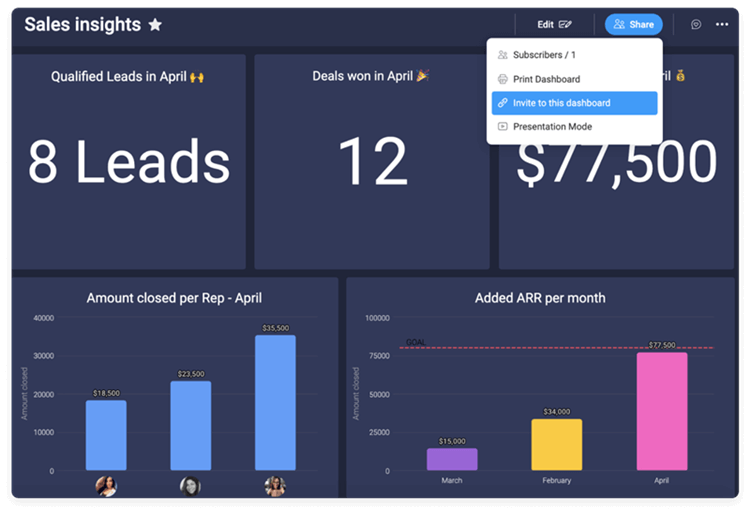
Monday Reporting Analytics
Templates
monday.com provides a treasure trove of totally configurable templates — over 200, to be exact — for every sort of company, industry, or team, including real estate, education, construction, human resources, and sales. Additionally, even our most basic package grants full access to all of them.
Mobile App
Monday.com now offers mobile apps for devices running the Android and iOS operating systems. You also can monitor the amount of time spent and the progress made on a project. Users can personalize the view and filter to display the relevant information, assign owners to tasks, and see tasks assigned to other members.
You can obtain real-time updates regarding tasks by utilizing the Monday.com mobile app, and you may contact team members using the @mention feature. You have control over which alerts you get, and the software also allows you to automate routine activities.
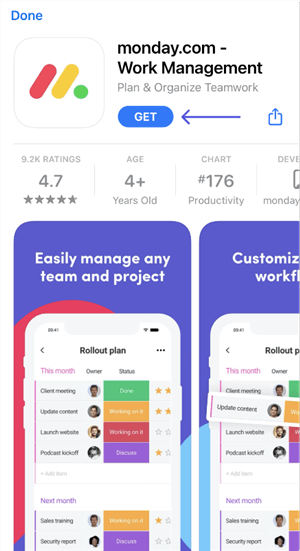
Monday Mobile App Interface
Pros of Wrike and Monday
Pros of Wrike
- You may personalize your dashboard by selecting items such as task lists, calendars, Gantt charts, and Kanban boards from the available choices. You may change or switch any board view with the push of a button to create the layout that best suits your needs.
- Using the Wrike mobile app, you and the other members of your team can work together on the same documents, files, and folders regardless of where you are. The program may be downloaded in the following dialects: English, French, Spanish, German, Italian, Japanese, and Portuguese. Russian is also an option.
- Working in the cloud necessitates maintaining the highest possible level of security. Wrike provides its user’s security mechanisms following the most widely accepted industry standards.
- Wrike is compatible with over 400 different applications, some of which include customer relationship management (CRM), single sign-on, file storage, chat, import/export, and email interfaces.
Pros of Monday
- The capacity to participate in a conversation and work together with other team members, irrespective of where in the globe they may be physically situated.
- Columns may be rearranged to handle various data kinds, including text, dates, tags, timelines, and persons.
- An open application programming interface (API) system that provides integrations and modifications that would be an incredible benefit for IT teams
- Enterprise-level capabilities for automation and security governance aspects (available on the enterprise version only)
Limitations of Wrike and Monday
Limitations of Wrike
- It is challenging with Wrike to add new users and to place them in appropriate projects. The project manager is required to manually add new users, which may be a time-consuming process for groups that have a lot of members.
- Wrike has a steep learning curve and is not user-friendly in any way. In point of fact, it takes a new user some time to master the fundamentals of how to use the program properly and to be up and running with it.
- The task management solution offered by Wrike does not provide appropriate priority for tasks. When it comes to a task, it only has a high significance setting.
- When compared to other available programs for project management on the market, Wrike is somewhat pricey.
Limitations of Monday
- When you utilize comments, it does not provide shortcuts for the keyboard. As a result, the communication pace may sometimes seem sluggish.
- Because the workflow automation option is only accessible on the most costly plans, it is not feasible for small businesses, freelancers, or agencies to purchase it.
- Because they do not give filters based on time, location, or billing kinds, the options for monitoring time are not as powerful as they might be.
Who Wins in Price?
Wrike Pricing
Wrike provides its customers with the following price plans:
- The Free Plan ($0 per user per month) is intended for smaller groups (up to five individuals) that need the most basic capabilities.
- The Professional Plan (which costs $9.80 per user per month) features capabilities for both planning and collaboration. This plan is paid per group of 5, 10, or 15 members.
- The Business Plan (which costs $24.80 per user per month) gives enterprises with 5–200 users access to more comprehensive customization options and robust reporting capabilities.
- The Enterprise Plan gives very sophisticated capabilities for managing projects, together with robust security measures (5-users with no limits)
Monday.com Pricing
Monday.com provides users with the following four payment options:
- The Basic plan costs $39 per user per month and is ideal for straightforward organizing and to-do list creation.
- The Standard plan costs $49 per person per month and has the capability that is too restrictive for larger organizations.
- The Pro plan costs $79 per user per month and offers more features for teams of medium size.
- The Enterprise plan (Quote) offers the highest level of functionality and is scaled to accommodate teams of any size.
Make a Choice between Wrike and Monday
Ask yourself the following questions before committing to either Wrike or Monday.com for your project management needs. Do you want a system that can be adapted to meet the specific requirements of your business? Do you want software that manages the projects you work on and other parts of your company from a single platform?
Wrike and Monday.com are two software examples that allow distributed teams to integrate digital work management solutions into their processes easily. The scalability and reliability of Wrike’s answers make them an excellent fit for the ever-expanding demands placed on today’s enterprises, which account for a significant portion of the company’s clientele. In addition, Wrike offers superior reporting features that enhance project visibility across departments and dependable enterprise-grade security to protect the most sensitive corporate data.
Startups and enterprises favour Monday.com with little resources, particularly those operating in the marketing, information technology, and software sectors. Both project management and process management are simplified with the help of their no-code and low-code tools, workflow templates, and rules-based automation. This makes it easier to manage workloads and keeps teams linked, so they can continue speaking and working together.
Final Words
As a result, Wrike and Monday.com are going back and forth with one another in this competition. Because of the little gap between the two products’ quality, individual taste may easily tilt the scales in any direction. It is in your best interest to give both options a test drive, evaluate how they make you feel, and make your decision based on how well they meet the requirements of your typical working day.
Monday.com has a decisive advantage in this fight, scoring four points to two. Although Wrike is far from being a poor option – its free plan is out of this world, and we enjoy how you can manage bigger projects – it does not have as many capabilities as monday.com, nor is it as user-friendly.

